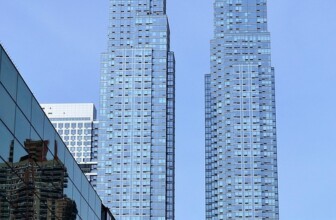How Your Surroundings Shape Success: The Impact of Environment on Productivity
Introduction
The environment we work and live in plays a crucial role in shaping our productivity and success. From natural landscapes to urban settings, the surroundings affect our mental state and motivation. This article explores the powerful influence of environment on productivity, examining everything from workspace design to social dynamics. Understanding these elements can lead to better strategies for enhancing personal and professional success.
In this detailed exploration, we will look at various factors including:
- The psychological impact of our surroundings
- How workspace design affects comfort and efficiency
- The importance of nature and green spaces
- The role of technology in creating productive environments
- How social dynamics shape our work experience
Section 1: Understanding Environmental Influences
The Psychology of Space
The psychology of space is a fascinating comprehensive area of study that examines how our immediate surroundings affect our thoughts and emotions. Spaces can either motivate or demotivate individuals. Numerous studies suggest that cluttered environments lead to increased stress levels and lower concentration. Conversely, organized and aesthetically pleasing spaces can enhance creativity and productivity.
A key factor in workspace enhancement is how personal space is perceived. When individuals feel they have possession over their environment, they tend to show greater satisfaction and productivity in their work. This idea is backed by Psychology Today, which discusses how individuals interact with their surroundings and how these interactions influence behavioral patterns.
Cultural Influences on Productivity
Cultural backgrounds significantly influence how individuals perceive their environments, which, in turn, affects their productivity. Different cultures have varying approaches to workspaces; for instance, some cultures emphasize a communal layout, while others lean towards private offices. Understanding these cultural dimensions is essential for global teams to function effectively.
According to Harvard Business Review, cultural orientation can dictate communication styles and workplace norms, thereby affecting overall productivity levels within multinational organizations. Embracing cultural diversity in the workplace can lead to innovative ideas and improved teamwork.
Section 2: The Role of Workspace Design
Ergonomics and Comfort
Workspace design is more than aesthetics; it’s about creating environments that foster productivity through comfort and ergonomics. Ergonomic workspaces prioritize the physical well-being of employees, reducing the risk of repetitive strain injuries and enhancing focus. Features like adjustable desks, supportive seating, and proper lighting are essential for maximizing efficiency.
According to the American Psychological Association, ergonomic design impacts productivity positively, leading to a healthier and more engaged workforce. When employees feel comfortable and safe in their environment, they are more likely to perform better.
Color Psychology in Workspaces
The colors in a workspace can have a profound impact on our mood and productivity levels. For instance, colors like blue and green are often found to have a calming effect, while colors such as yellow and orange can stimulate creativity and energy. Understanding color psychology can be an effective tool for spatial design.
Research featured in CBC indicates that specific colors can even motivate individuals by influencing their emotions and mental clarity. Selecting the right color palette for offices can enhance workplace efficiency and employee satisfaction.
Section 3: The Impact of Nature
Biophilic Design
Biophilic design involves incorporating elements of nature into urban environments to enhance well-being and productivity. This approach is rooted in the idea that humans have an inherent connection to nature, and access to natural elements can significantly improve cognitive function and emotional health.
Research published by NAIOP provides evidence that biophilic design elements, such as living walls and indoor greenery, promote better air quality and reduce stress among employees. Investing in biophilic designs can result in increased employee retention and higher productivity.
Access to Outdoor Spaces
Having access to outdoor spaces can significantly influence workplace dynamics. Whether through outdoor offices or gardens, research shows that spending time outside enhances mood, reduces stress, and consequently leads to greater productivity levels.
According to a study from Frontiers in Psychology, employees with access to natural settings are less likely to experience burnout and are more innovative. Therefore, organizations should consider integrating outdoor elements in their workspace planning.
Section 4: Technology and Environment
Smart Spaces
The advent of technology has introduced the concept of smart spaces, which leverage automation and data analytics to optimize how environments are experienced. This innovation allows for real-time adjustments based on user behavior, significantly enhancing comfort and productivity.
Studies by Forbes suggest that smart spaces can result in improved operational efficiency and employee morale, as personalized environments cater to individual needs and preferences.
Remote Work: Pros and Cons
The COVID-19 pandemic has brought remote work into the mainstream, making it essential to evaluate its effects on productivity. Working from home offers flexibility and can increase comfort, but it also presents challenges, such as isolation and distractions.
The Gallup report reveals mixed outcomes for productivity in remote settings, emphasizing the importance of a tailored environment to maximize effectiveness. Organizations must find ways to support employees in creating conducive workspaces at home.
Section 5: Social Environment
Collaboration and Team Dynamics
The social aspects of the workplace can significantly impact productivity levels. Collaborative environments stimulate creativity and innovation, while isolated setups can lead to disengagement. Organizations that understand and promote social interaction can harness the diverse talents of their workforce.
Research indicates that companies fostering teamwork experience improved problem-solving capabilities and a sense of belonging among employees, which directly correlates with productivity. The WeWork Blog highlights strategies for enhancing collaborative cultures that boost productivity.
Networking and Community Influence
A strong professional network can enhance productivity by providing resources, support, and inspiration. Engaging in industry communities fosters idea-sharing and collaboration, promoting innovation and efficiency.
Platforms such as LinkedIn provide invaluable opportunities for individuals to network, leading to increased motivation and new insights, ultimately shaping their work environment positively. Articles on Harvard Business Review discuss the importance of cultivating these connections for career advancement.
Section 6: Personal Environment
Home Office Optimization
Creating a dedicated home office is essential for remote workers to maintain productivity. An optimized home working space acts as a barrier between work and life, helping enhance focus and efficiency.
Effective home office setups involve ergonomic furniture, proper lighting, and minimal distractions. Research published by ResearchGate indicates that thoughtful home office designs can greatly improve productivity levels, helping employees achieve work-life balance.
Decluttering for Success
A clutter-free environment can significantly boost productivity. Clutter can lead to feelings of anxiety and overwhelm, impacting focus and motivation. Tidying up one’s physical space can lead to clearer thinking and enhanced creativity.
The philosophy of minimalism has gained popularity, as it emphasizes simplicity and intentionality, which translate into improved productivity. Sources like Becoming Minimalist illustrate how decluttering can improve one’s focus and creative output.
Section 7: Case Studies
Corporate Examples
Several corporations have successfully integrated environmental strategies to enhance productivity. For example, Google’s workspaces are designed to encourage collaboration and creativity, featuring open areas, natural light, and various recreational spaces that boost employee morale and engagement.
Furthermore, studies have shown that companies that invest in positive work environments often see lower turnover rates and better employee satisfaction. Download the comprehensive study from Forbes to explore how Google approaches workplace design.
Personal Experiences
On an individual level, many professionals have shared their success stories regarding the creation of an inspiring work environment. For example, writer and entrepreneur Tim Ferriss attributes much of his productivity to cultivating an inspired home office setup tailored to his individual needs.
His approach of balancing aesthetics with functionality illustrates how personal environments can enhance focus. A deeper dive into his experiences can be found on Tim Ferriss's Blog.
Section 8: Strategies for Improvement
Creating a Productive Environment
Enhancing your surroundings for increased productivity requires a holistic approach. Consider these strategies:
- Assess your current environment: Identify distractions and potential improvements.
- Incorporate natural elements: Use plants or natural light whenever possible.
- Prioritize comfort: Invest in ergonomic furniture that enhances well-being.
- Utilize color strategically: Choose color palettes that inspire focus and creativity.
- Foster connection: Create opportunities for social interaction and collaboration.
Tools and Resources
Using the right tools is vital for creating an environment conducive to productivity. Here are some helpful resources:
- Ergonomic Tools: Invest in adjustable chairs and desks.
- Indoor Plants: Incorporate nature into your workspace with houseplants.
- Lighting Solutions: Use lamps that provide adequate lighting without harsh glare.
- Organizer Tools: Utilize storage solutions to keep your space tidy.
- Online Communities: Engage in forums for support and idea-sharing.
Q&A Section
In this section, we address some common queries related to how surroundings shape success and productivity.
- Q: Can a messy workspace really affect my productivity?
A: Yes, clutter can distract you and heighten feelings of stress, impacting your performance. - Q: How does natural light influence productivity?
A: Natural light can improve mood and energy levels, positively affecting productivity. - Q: Are open office layouts effective for improving collaboration?
A: Open layouts can enhance collaboration for some, but may also distract others—balancing different work styles is crucial. - Q: How important is company culture in shaping productivity?
A: Company culture sets the tone for employee engagement and overall productivity levels. - Q: What role does technology play in modern work environments?
A: Technology can facilitate communication, improve efficiency, and create smarter workspaces.
FAQ Section
Here are some frequently asked questions about how your surroundings shape success:
- Q: What is the most significant factor in creating a productive workspace?
A: The most significant factor can vary between individuals but often includes comfort, organization, and natural elements. - Q: How can I enhance my home office's productivity?
A: Focus on ergonomics, minimize distractions, and design a space that inspires you. - Q: What influences productivity more, physical or social environment?
A: Both are crucial—physical comfort can drive focus, while a supportive social environment enhances collaboration and creativity. - Q: How does color psychologically affect productivity?
A: Colors can evoke specific emotions and energy levels; thus, they should be thoughtfully chosen based on desired outcomes. - Q: How can I keep my workspace organized?
A: Consider minimalist design, maintain a regular cleaning schedule, and use organizers to keep your workspace tidy.
Resources
| Source | Description | Link |
|---|---|---|
| Psychology Today | Insights into environmental psychology | Visit |
| Harvard Business Review | Articles on cultural influences in workspaces | Visit |
| Forbes | Trends in smart technologies for workspaces | Visit |
| Gallup | Insights on remote work productivity | Visit |
| Becoming Minimalist | How minimalism boosts productivity | Visit |
Conclusion
As evidenced throughout this article, the environment profoundly shapes success and productivity. From workspace design to the social dynamics at play, various factors contribute to how effectively we perform. By understanding and optimizing our surroundings, we can cultivate environments that inspire and motivate us towards success.
Investing in personalized, comfortable, and inspiring environments will not only enhance productivity but also lead to greater satisfaction and creativity. Organizations and individuals alike must embrace these insights to fully realize their potential.
Disclaimer
This article was created with assistance from artificial intelligence (AI) to enhance research and drafting efficiency. All content has been reviewed and refined by human contributors.










